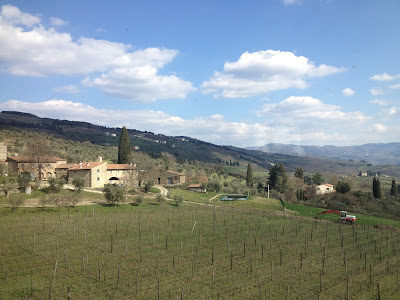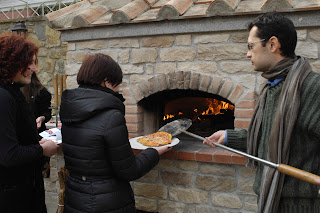Right at the end of the Uffizi line, through a doorway between the statues of Lorenzo the Magnificent and his father Cosimo the Elder de' Medici, is an Easter gift
to residents and visitors to Florence alike.
Past the entrance and a room with 20th sculptures by Marino Marini and Venturini
is the crypt of the former church of San Pier Scheraggio and a display of three medieval crucifix panels
(open 9 am - 8 pm, free admission!) for the Easter holidays.
The most expressive one, in the center of the crypt, is the above 13th century Crucifix from Pisa. With resplendent gold work framing a tranquil, wide-eyed Christ and Stories from the His Passion--including the Betrayal and the Deposition--the tempera on panel work displays a variety of influences. Since Pisa was a seaport at that time, the town absorbed the visual languages of Mediterranean lands as varied as Syria and Palestine to Sicily, famed for its mosaics of Arab inspiration.
While this tranquil Christ, with wavy hair coiling on his shoulders, seems to have transcended his suffering,
this cannot be said for the another Crucifix panel displayed in the same room.
Head bowed, eyes closed and hands oozing blood, this Christ was also created in the first half
of the 13th century in and around Lucca, not far from Pisa. The scenes from the Passion surrounding the figure depict Christ in various mournful scenes, from the Judgement before Pilate, to carrying the cross, to the Deposition, the Entombment and finally and an angel standing between an empty tomb and the
three Marys
who seek Christ on Easter morning.
This Crucifix is attributed to the so-called "Master of the Cross," who in turn was to inspire Coppo di Marcovaldo, the artistic precursor to Cimabue and Giotto, who was to introduce the
revolutionary Renaissance style.
Recently restored thanks to funding by the Amici degli Uffizi (Friends of the Uffizi),
the works displayed in San Pier Scheraggio will be moved to Room 2 of the Uffizi,
in the company of the the two above-mentioned crucifix panels and another by Duccio.

There is even an angel in a pink rose robe holding a globe with feet firmly on a dragon devil.
Evil will be overcome, life goes on.
Maybe it will even stop raining.
Buona Pasqua
from Beautiful Florence
three Marys
who seek Christ on Easter morning.
This Crucifix is attributed to the so-called "Master of the Cross," who in turn was to inspire Coppo di Marcovaldo, the artistic precursor to Cimabue and Giotto, who was to introduce the
revolutionary Renaissance style.
Recently restored thanks to funding by the Amici degli Uffizi (Friends of the Uffizi),
the works displayed in San Pier Scheraggio will be moved to Room 2 of the Uffizi,
in the company of the the two above-mentioned crucifix panels and another by Duccio.
Christ is KO in the third exhibit, a diptyph (a smaller, two panel piece); in fact Mary in the scene below His armpit has fainted. Again created in Lucca early 13th century, Christ's elongated body seems to
presage the distinctive figures in the paintings of the Renaissance artists El Greco.
Looking at this work, it is clearly Good Friday in Passion Week, which today actually is.
With rain non-stop since Christmas, no government formed as a result of the February elections and problems stemming from a deep recession, Italy can be said to be currently experiencing its own
Via Crucis,
Stations of the Cross before the Crucifixion.
Stations of the Cross before the Crucifixion.
But guess what? Easter is around the corner--that means Resurrection and a new start.
Maybe it is no coincidence that the other part of the diptych panel portrays
Mary and a newborn Christ.
Mary and a newborn Christ.

There is even an angel in a pink rose robe holding a globe with feet firmly on a dragon devil.
Evil will be overcome, life goes on.
Maybe it will even stop raining.
Buona Pasqua
from Beautiful Florence

















